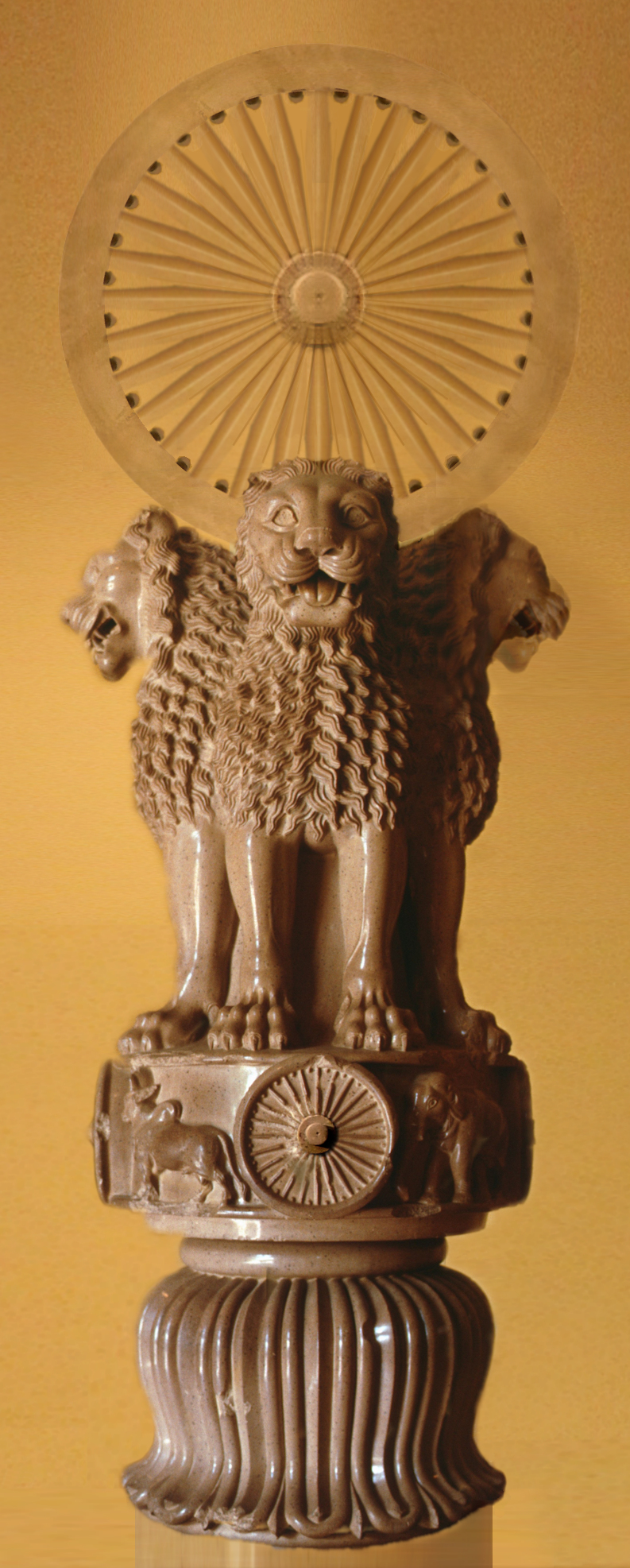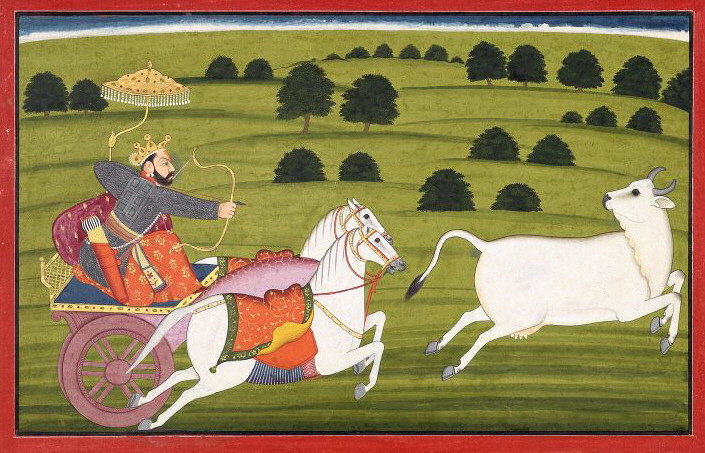|
Lauria Nandangarh
Lauria Nandangarh, also Lauriya Navandgarh, is a city or town about 14 km from Narkatiaganj (or Shikarpur) and 28 km from Bettiah in West Champaran district of Bihar state in northern India. It is situated near the banks of the Burhi Gandak River. The village draws its name from a pillar (laur) of Ashoka standing there and the stupa mound Nandangarh (variant Nanadgarh) about 2 km south-west of the pillar. Lauriya Nandangarh is a historical site located in West Champaran district of Bihar. Remains of Mauryan period have been found here. History & Archaeological Excavations Lauriya has 15 Stupa mounds in three rows, each row upwards of 600 m; the first row begins near the pillar and goes E to W, while the other two are at right angles to it and parallel to each other. Alexander Cunningham partially excavated one of them in 1862 and found a retaining wall of brick (size 51 X 20 cm). A few years later Henry Bailey Wade Garrick excavated several moun ... [...More Info...] [...Related Items...] OR: [Wikipedia] [Google] [Baidu] [Amazon] |
Pillars Of Ashoka
The pillars of Ashoka are a series of Monolith, monolithic columns dispersed throughout the Indian subcontinent, erected—or at least inscribed with Edicts of Ashoka, edicts—by the 3rd Mauryan Emperor Ashoka the Great, who reigned from to 232 BC. Ashoka used the expression ''Dhaṃma thaṃbhā'' (Dharma stambha), i.e. "pillars of the Dharma" to describe his own pillars. These pillars constitute important monuments of the architecture of India, most of them exhibiting the characteristic Mauryan polish. Twenty of the pillars erected by Ashoka still survive, including those with inscriptions of his edicts. Only a few with animal capitals survive of which seven complete specimens are known. Two pillars were relocated by Firuz Shah Tughlaq to Delhi Sultanate, Delhi. Several pillars were relocated later by Mughal Empire rulers, the animal capitals being removed.Krishnaswamy, 697-698 Averaging between in height, and weighing up to 50 tons each, the pillars were dragged, sometimes ... [...More Info...] [...Related Items...] OR: [Wikipedia] [Google] [Baidu] [Amazon] |
Stupa
In Buddhism, a stupa (, ) is a domed hemispherical structure containing several types of sacred relics, including images, statues, metals, and '' śarīra''—the remains of Buddhist monks or nuns. It is used as a place of pilgrimage and meditation. Walking around a stupa in a clockwise direction, known as '' pradakhshina'', has been an important ritual and devotional practice in Buddhism since the earliest times, and stupas always have a ''pradakhshina'' path around them. The original South Asian form is a large solid dome above a tholobate, or drum, with vertical sides, which usually sits on a square base. There is no access to the inside of the structure. In large stupas, there may be walkways for circumambulation on top of the base as well as on the ground below it. Large stupas have, or had, ''vedikā'' railings outside the path around the base, often highly decorated with sculpture, especially at the torana gateways, of which there are usually four. At the top of ... [...More Info...] [...Related Items...] OR: [Wikipedia] [Google] [Baidu] [Amazon] |
Amalananda Ghosh
Amalananda Ghosh (3 March 1910 – 1981) was an Indian archaeologist, author and editor of numerous works on India's ancient civilizations, and the organizer and director of archaeological expeditions during the mid-1900s. Education Ghosh was born on 3 March 1910 in Varanasi, India. He was educated in Varanasi and Allahabad and later received advanced training at the Institute of Archaeology at the University of London.An Encyclopedia of Indian Archaeology, Edited by Amalananda Ghos accessed 24 August 2011. Career Ghosh joined the Archaeological Survey of India in 1937 and eventually rose to become its Director-General. He served in that position from 1953 to 1968. During his period with the Survey, Ghosh led or participated in a number of excavations, including investigations at Pachmarhi, Bikaner, Brahmagiri, Maski, Taxila, Arikamedu, and Harappa. In 1950, Ghosh organized and began a systematic exploration of the Bikaner site, along the dried-up bed of the ancient Sa ... [...More Info...] [...Related Items...] OR: [Wikipedia] [Google] [Baidu] [Amazon] |
Stupas
In Buddhism, a stupa (, ) is a domed hemispherical structure containing several types of sacred relics, including images, statues, metals, and '' śarīra''—the remains of Buddhist monks or nuns. It is used as a place of pilgrimage and meditation. Walking around a stupa in a clockwise direction, known as '' pradakhshina'', has been an important ritual and devotional practice in Buddhism since the earliest times, and stupas always have a ''pradakhshina'' path around them. The original South Asian form is a large solid dome above a tholobate, or drum, with vertical sides, which usually sits on a square base. There is no access to the inside of the structure. In large stupas, there may be walkways for circumambulation on top of the base as well as on the ground below it. Large stupas have, or had, ''vedikā'' railings outside the path around the base, often highly decorated with sculpture, especially at the torana gateways, of which there are usually four. At the top of ... [...More Info...] [...Related Items...] OR: [Wikipedia] [Google] [Baidu] [Amazon] |
Piprahwa
Piprahwa is a village near Siddharthnagar city in Siddharthnagar district of the Indian state of Uttar Pradesh. Kalanamak rice, a scented and spicy variety, is grown in this area. It lies in the heart of the historical Buddha's homeland and is 9 miles from the world heritage site of Lumbini that is believed to be the place of Gautama Buddha's birth. Piprahwa is best known for its archaeological site and excavations that suggest that it was the burial place of the portion of the Buddha's ashes that were given to his own Shakya clan. A large stupa and the ruins of several monasteries as well as a museum are located within the site. Ancient residential complexes and shrines were uncovered at the adjacent mound of Ganwaria. Passing of the Buddha The history of the Piprahwa stupa begins with the passing of the Buddha. The Mahāparinibbāna Sutta says that an argument arose following his cremation around 480 BCE. 'The Sakyas of Kapilavatthu came to know that at Kusinara the B ... [...More Info...] [...Related Items...] OR: [Wikipedia] [Google] [Baidu] [Amazon] |
Nani Gopal Majumdar
Nani may refer to: People * Alla Nani (born 1969), Indian politician *Nanai people of north Asia * Nani (actor) (born 1984), Indian actor *Nani (footballer) Luís Carlos Almeida da Cunha (born 17 November 1986), commonly known as Nani (), is a Portuguese former professional Association football, footballer who played as a Midfielder#Winger, winger. He was known for his pace, flair and work ethic. ... (born 1986), Portuguese footballer * Antonio Nani (1842–1929), Maltese classical composer * Gianluca Nani (born 1962), former technical director at West Ham United * Kesineni Nani (born 1966), Indian politician * Kodali Nani, Indian politician * Nanabhoy Palkhivala (1920–2002), Indian jurist and economist * Nani Roma (born 1972) a Spanish rally racing driver * Nani Alapai (1874–1928), Hawaiian soprano vocalist * Nani family of Venice, members of which owned various palazzi: ** Palazzo Barbarigo Nani Mocenigo ** Palazzo Bernardo Nani ** Palazzo Erizzo Nani Mocenigo ** Palazz ... [...More Info...] [...Related Items...] OR: [Wikipedia] [Google] [Baidu] [Amazon] |
Gautama Buddha
Siddhartha Gautama, most commonly referred to as the Buddha (),* * * was a śramaṇa, wandering ascetic and religious teacher who lived in South Asia during the 6th or 5th century BCE and founded Buddhism. According to Buddhist legends, he was born in Lumbini, in what is now Nepal, to royal parents of the Shakya clan, but Great Renunciation, renounced his Householder (Buddhism), home life to live as a wandering ascetic. After leading a life of mendicancy, asceticism, and meditation, he attained Nirvana (Buddhism), nirvana at Bodh Gaya, Bodh Gayā in what is now India. The Buddha then wandered through the lower Indo-Gangetic Plain, teaching and building a Sangha, monastic order. Buddhist tradition holds he died in Kushinagar and reached ''parinirvana'' ("final release from conditioned existence"). According to Buddhist tradition, the Buddha taught a Middle Way between sensual indulgence and severe asceticism, leading to Vimutti, freedom from Avidyā (Buddhism), ignora ... [...More Info...] [...Related Items...] OR: [Wikipedia] [Google] [Baidu] [Amazon] |
Mound
A mound is a wikt:heaped, heaped pile of soil, earth, gravel, sand, rock (geology), rocks, or debris. Most commonly, mounds are earthen formations such as hills and mountains, particularly if they appear artificial. A mound may be any rounded area of topography, topographically higher elevation on any surface. Artificial mounds have been created for a variety of reasons throughout history, including habitation (see Tell (archaeology), Tell and Terp), ceremonial (platform mound), burial (tumulus), and commemorative purposes (e.g. Kościuszko Mound). Archaeology North American archaeology In the archaeology of the United States and Canada, a mound is a deliberately constructed elevated earthen structure or earthworks (engineering), earthwork, intended for a range of potential uses. In European and Asian archaeology, the word "tumulus" may be used as a synonym for an artificial hill, particularly if the hill is related to particular burial customs. While the term "mound" may ... [...More Info...] [...Related Items...] OR: [Wikipedia] [Google] [Baidu] [Amazon] |
Vedic
upright=1.2, The Vedas are ancient Sanskrit texts of Hinduism. Above: A page from the '' Atharvaveda''. The Vedas ( or ; ), sometimes collectively called the Veda, are a large body of religious texts originating in ancient India. Composed in Vedic Sanskrit, the texts constitute the oldest layer of Sanskrit literature and the oldest scriptures of Hinduism. There are four Vedas: the Rigveda, the Yajurveda, the Samaveda and the Atharvaveda. Each Veda has four subdivisions – the Samhitas ( mantras and benedictions), the Brahmanas (commentaries on and explanation of rituals, ceremonies and sacrifices – Yajñas), the Aranyakas (text on rituals, ceremonies, sacrifices and symbolic-sacrifices), and the Upanishads (texts discussing meditation, philosophy and spiritual knowledge).Gavin Flood (1996), ''An Introduction to Hinduism'', Cambridge University Press, , pp. 35–39A Bhattacharya (2006), ''Hindu Dharma: Introduction to Scriptures and Theology'', , pp. 8–14; George ... [...More Info...] [...Related Items...] OR: [Wikipedia] [Google] [Baidu] [Amazon] |
Prithvi
Prithvi (Sanskrit: पृथ्वी, ', also पृथिवी, ', "the Vast One", also rendered Pṛthvī Mātā), is the Sanskrit name for the earth, as well as the name of the goddess-personification of it in Hinduism. The goddess Prithvi is an archetypal Mother Goddess, and one of the most important goddesses in the historical Vedic religion. She is depicted as a stable, fertile, and benevolent presence in the Vedas. She is frequently addressed as a mother, and a nurturing, generous goddess who provides sustenance to all beings living on her vast, firm expanse. While the ''Rigveda'' predominantly associates her with Dyaus ('Father Sky'), the ''Atharvaveda'' and later texts portray her as an independent deity. In classical Hinduism, the figure of Prithvi is supplanted by the goddess Bhumi, while the term Prithvi serves as one of her epithets. She becomes significantly associated with Vishnu, one of the most important gods in later Hinduism, and his avatars—Varaha ... [...More Info...] [...Related Items...] OR: [Wikipedia] [Google] [Baidu] [Amazon] |
Vedas
FIle:Atharva-Veda samhita page 471 illustration.png, upright=1.2, The Vedas are ancient Sanskrit texts of Hinduism. Above: A page from the ''Atharvaveda''. The Vedas ( or ; ), sometimes collectively called the Veda, are a large body of religious texts originating in ancient India. Composed in Vedic Sanskrit, the texts constitute the oldest layer of Sanskrit literature and the oldest Hindu texts, scriptures of Hinduism. There are four Vedas: the Rigveda, the Yajurveda, the Samaveda and the Atharvaveda. Each Veda has four subdivisions – the Samhitas (mantras and benedictions), the Brahmanas (commentaries on and explanation of rituals, ceremonies and sacrifices – Yajñas), the Aranyakas (text on rituals, ceremonies, sacrifices and symbolic-sacrifices), and the Upanishads (texts discussing meditation, philosophy and spiritual knowledge).Gavin Flood (1996), ''An Introduction to Hinduism'', Cambridge University Press, , pp. 35–39A Bhattacharya (2006), ''Hindu Dharma: Introduc ... [...More Info...] [...Related Items...] OR: [Wikipedia] [Google] [Baidu] [Amazon] |







